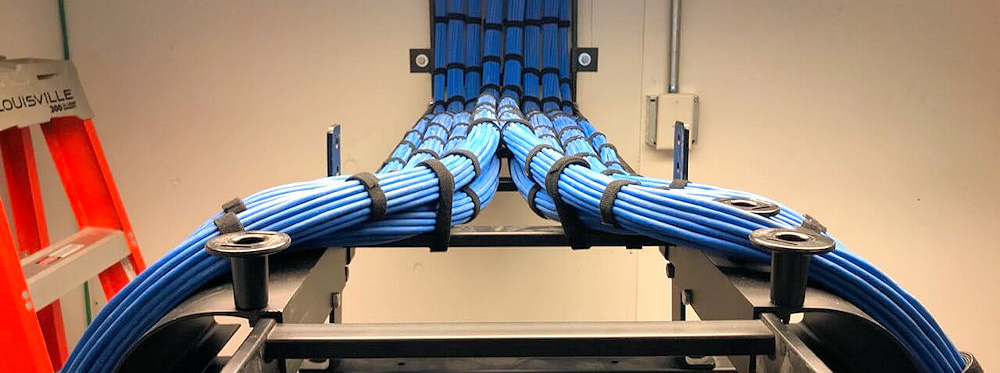Structured Cabling Brands
What is the purpose of structured cabling?
Increased efficiency: Well-maintained, structured cabling systems can improve data transmission through your network. The reason is that cables are connected in pre-determined places, which eliminates the need to add bulk or port extension cords.

What are the 2 main standards of structured cabling?
A structured cabling system (SCS) is a way of organizing and managing the combined cabling of wiring and communications apparatus in an organization. It is typically implemented in buildings where multiple organizations or teams share common infrastructure, as well as within centralized networks (architecture). A SCS separates facility wiring into sections, typically numbering from one to five, each representing a category of usage.
Neighborhoods We Service
We've provided Structured Cabling and Data Cabling to our customers in Dallas starting in 2006. From TX State Highway 75 to I635 & I30 / I20, we've provided service to customers in neighborhoods like:
Dallas Downtown Historic District - Deep Ellum - Far North Dallas - Uptown - South Dallas - Bishop Arts District - Lake Highlands - West Dallas - Arts District - Preston Hollow
Gladly Servicing The Amazing Texas Hometown of Dallas
Our Dallas Office
Find Us On The Web!
Contact us today to get going with your FREE Data Cabling Evaluation & Quote by calling us direct (number below) or visit us online. Give us a call: (214) 251-5237 Site: https://shelbycommunications.com Shelby Communications - 1505 Denise CT, Keller, TX 76248
What is structured cabling and give its types?
There are many ways in which structured cabling can benefit an organization. Some of the benefits of structured cabling include:


Is structured cabling low voltage?
Structured cabling involves using multiple types of cabling with their own advantages and disadvantages to create a communication network that is simple to manage and maintain. There are several types of cabling that can be used in structured cabling systems. These include Category 5 for high-speed data traffic and Category 3 for medium speed data traffic. Category 2 is for voice circuits and category 5e (or higher) for video and sound.
Does structured cabling is recommended for all Organization Why?
A lot has been said recently about the evils of Structured Cabling and the threat it poses to the electric grid. In reality, however, structured cabling is one of the key technologies that helps protect the electric grid from potentially devastating outages. There are a number of misconceptions about structured cabling that need to be addressed. First and foremost, it's not low voltage wiring that causes problems on the electric grid, it's inadequate maintenance and installation of low voltage systems that eventually cause problems. Second, every layer of the electric grid is connected to each other. So if there is an issue with one part of the network, it can quickly cascade throughout the entire system. Structured cabling can help prevent this from happening by providing a reliable high-speed data transmission path for electric utilities. In short, structured cabling is a vital part of maintaining and protecting the electric grid – it's simply not as bad as some believe.


How do you install structured cabling?
A well-designed network will provide faster speeds and better performance to all devices that are connected to it. Structured cabling provides a better cable management system that can help improve network performance. A backbone cable (also known as spine or mid-spine) is a network cable that links the different components of a LAN. Backbone cables are essential for connectivity between workstations, storage devices, and peripheral devices. Because they can withstand more abuse and loading, they are often thicker than regular cables.
What are the six cabling subsystems?
Increased Security: With a properly installed and configured system, organized cabling provides a secure backbone for your network. This system can help protect your network from unauthorized access, theft, and other forms of vandalism.

Does structured cabling is recommended for all Organization Why?
An organized cabling system is essential in any office environment. When there are several different devices that are being used at the same time, a more straightforward and structured cabling system is the way to go.
What are the 2 main standards of structured cabling?
The ANSI/ITA-568 and ISO/IEC 11801 are the two names you need to know because these two are the main structured cabling standards.
What are the six cabling subsystems?
Know the 6 subsystems of a structured cabling system Entrance Facilities (EF) ... Equipment Room (ER) ... Backbone Cabling. ... Telecommunications Room (TR) and Telecommunications Enclosure (TE) ... Horizontal Cabling – (Cabling Subsystem 1)
What is structured cabling and give its types?
In telecommunications, structured cabling is building or campus cabling infrastructure that consists of a number of standardized smaller elements (hence structured) called subsystems. Structured cabling components include twisted pair and optical cabling, patch panels and patch cables.
What is a TIA standard?
TIA/EIA-568-A-1995 (Commercial Building Telecommunications Wiring Standards) Defines a standard for building cable system for commercial buildings that support data networks, voice, and video. It also defines the technical and performance criteria for cabling.
What is a backbone cable?
The backbone is the portion of the network cabling which connects across the various rooms and communication panels, carrying the largest number of fibres and normally constituting the longest cable run. Example backbone includes DeviceNet Thick cable.